Key takeaways:
- Retrospectives foster team cohesion and create a safe space for honest dialogue, leading to improved communication and trust among team members.
- Effective retrospectives require clear action plans, focusing on actionable outcomes and celebrating successes, which enhances team motivation and accountability.
- Incorporating diverse techniques, such as silent brainstorming and rotating facilitators, can invigorate discussions and encourage participation from all team members.
- Cultivating a culture of recognition and follow-up actions after retrospectives can significantly improve team dynamics and ensure accountability for commitments made.
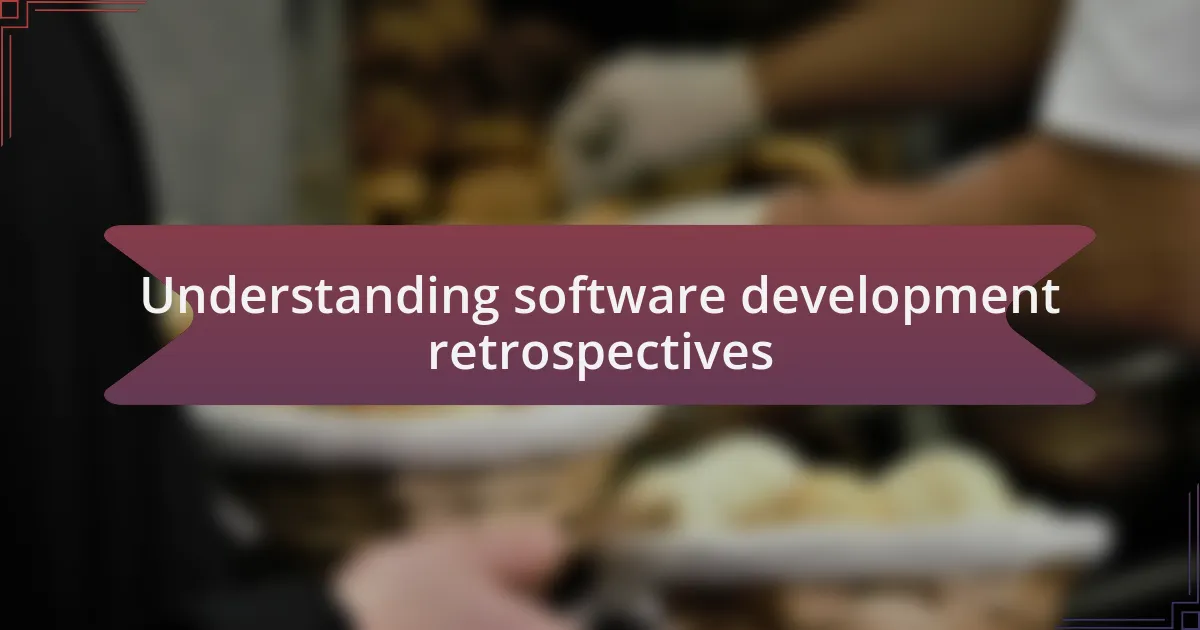
Understanding software development retrospectives
Software development retrospectives are vital for continuous improvement within teams. Reflecting on what worked and what didn’t allows us, as developers, to openly share our experiences. I remember a retrospective where we discovered a recurring bottleneck that, once addressed, significantly improved our workflow.
In our discussions, emotions often run high, but this honesty cultivates a safe space for vulnerability. I often ask myself—how can we create a more productive environment? Through these sessions, I’ve learned that fostering trust and encouraging open communication leads to more profound insights about team dynamics and project challenges.
The beauty of retrospectives lies in their ability to transform frustration into actionable steps. One time, our team faced a major project setback that seemed insurmountable. Instead of dwelling on the negatives, we used our retrospective to turn that experience into a checklist for future projects. By sharing stories, we not only learned from mistakes but also celebrated our achievements, reinforcing a culture of growth and resilience.
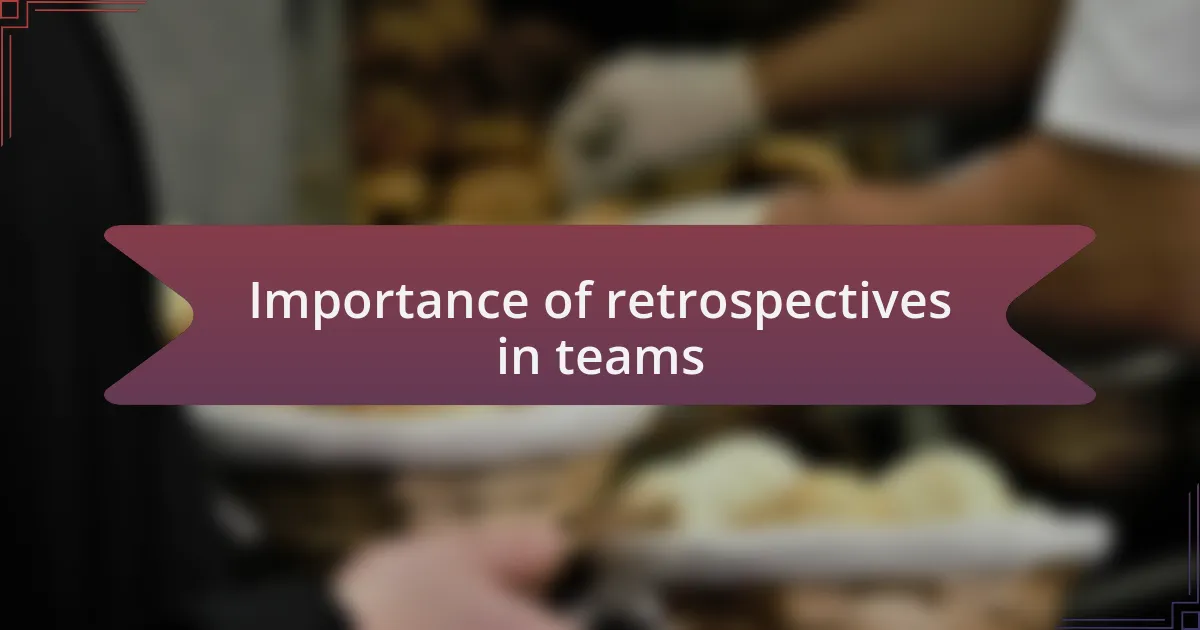
Importance of retrospectives in teams
One significant aspect of retrospectives is their role in building team cohesion. I recall a time when our team struggled with miscommunication, which led to frustration and delays. During a retrospective, we not only addressed the issues but also shared personal stories that helped us understand each other better. This openness transformed our approach and made us feel like a united front rather than just a group of individuals.
Retrospectives also provide an opportunity for recognition, which I find crucial in maintaining team morale. I once suggested we highlight individual contributions at the end of each session. This small adjustment had a profound effect. It made team members feel valued and motivated to continue contributing, reinforcing the idea that every effort counts. Have you ever noticed how a simple “thank you” can change someone’s day? This is exactly what these sessions can achieve.
Lastly, I believe retrospectives challenge us to think critically about our processes. There was a moment when our sprint planning had become chaotic. Instead of merely pointing fingers, we collaboratively analyzed the certain practices that were hindering us. This process required vulnerability but ultimately led to innovative solutions that transformed our planning sessions. How can we afford to ignore such valuable insights? Retrospectives are more than just a routine; they are a catalyst for real change.
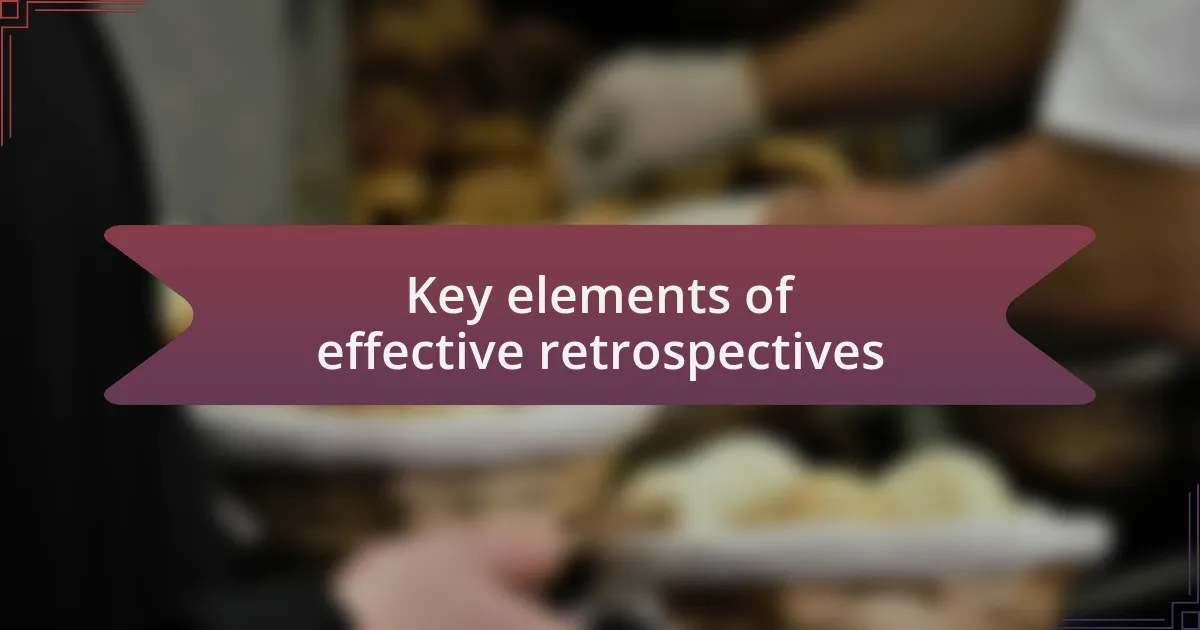
Key elements of effective retrospectives
Effective retrospectives hinge on creating a safe space for candid dialogue. I remember a particularly transformative session where we implemented a rule: no blaming, only solutions. This mindset shift made it easier for team members to voice their frustrations without fear of judgment, ultimately leading us to identify underlying issues that we had previously overlooked. Have you ever felt that the fear of repercussions stifles honest conversation? In that moment, we learned how essential safety is for genuine reflection.
Another key element is focusing on actionable outcomes. During one retrospective, we explored the chaos during deployment cycles and identified specific areas for improvement. By breaking down our action items into smaller, manageable tasks, we not only clarified our next steps but also built accountability within the team. I still recall the feeling of accomplishment when we revisited our commitments in the following session, demonstrating that progress could be tracked and celebrated. Isn’t it refreshing to see tangible results from our discussions?
Lastly, celebration should not be overlooked. An anecdote comes to mind when we dedicated a portion of a retrospective to share successes—big and small. It transformed the atmosphere from merely problem-seeking to one of appreciation and optimism. I find it vital to recognize that every win, no matter how minor, contributes to our team’s momentum and positivity. How often do we stop to acknowledge our achievements in the midst of the hustle? Making celebration a routine part of retrospectives reinforced our team spirit and made tackling the next challenges all the more enjoyable.
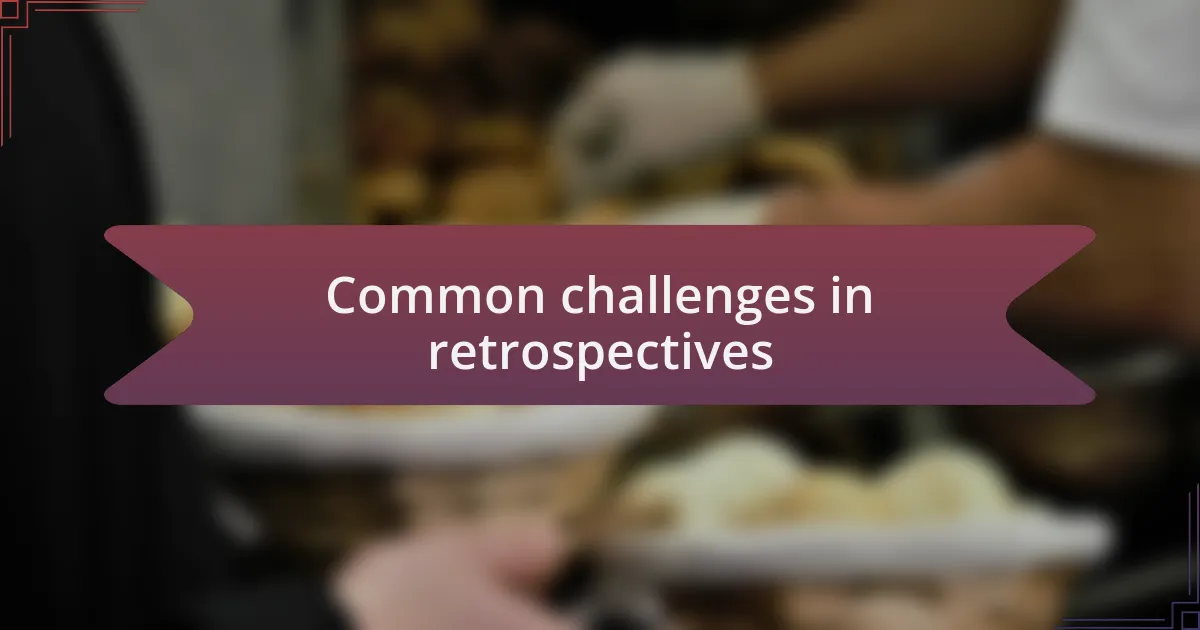
Common challenges in retrospectives
One common challenge I often encountered during retrospectives is disengagement from team members. I recall a time when our meetings felt more like obligatory attendance rather than an engaging discussion. I began to wonder, how can we encourage everyone’s voice to be heard? It struck me that mixing up our formats—like incorporating break-out sessions or interactive polls—could energize participation and make team members feel genuinely involved.
Another obstacle is the tendency to dwell on negative feedback and failures without a constructive outlook. In one retrospective, a heated debate erupted over a particularly problematic sprint. I felt the atmosphere grow tense, and it became apparent that we were stuck in a loop of blame rather than focusing on improvement. This experience led me to ask, what if we framed our challenges as opportunities for learning? Shifting our perspective helped us transition from a blame culture to one where we sought solutions together.
Finally, a lack of clear actionable items can hinder the effectiveness of retrospectives. I remember concluding a session with countless ideas but no one really knowing the next steps. It was frustrating! This prompted me to implement a “SMART” (Specific, Measurable, Achievable, Relevant, Time-bound) framework for our action items. By clearly defining the who, what, and when, we turned a confusing mess into a structured plan of action. How could we ever track progress if we weren’t clear about our objectives? This change made all the difference, and it felt rewarding to see our ideas transform into concrete actions.
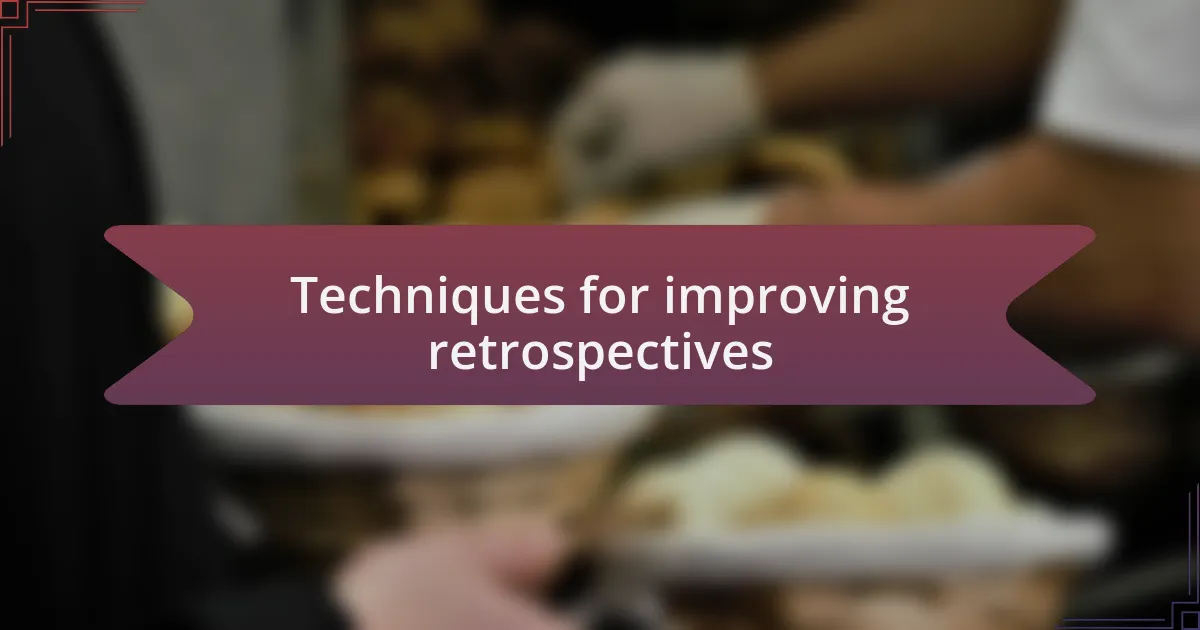
Techniques for improving retrospectives
One technique I found particularly effective in improving retrospectives is the use of a “start, stop, continue” format. During a session, I introduced this framework, and it sparked immediate engagement. Team members began to share their insights freely, discussing what practices we should start doing, which habits to stop, and what processes were worth continuing. I noticed that this structure not only organized our thoughts but also fostered a more balanced conversation, making everyone feel invested in the outcomes.
In another instance, I experimented with a “silent brainstorming” session prior to the open discussion. Each team member wrote down their thoughts on sticky notes, and once we gathered, we grouped them by common themes. I was amazed by how this method drew out ideas that would have otherwise remained unspoken. It was fascinating to see how a little silence could create a space for thoughtful reflection, allowing even the quieter members of the team to express their viewpoints without interruption.
Lastly, incorporating a rotating facilitator role has significantly enhanced our retrospectives. I vividly remember the first time a junior developer led the session. It was refreshing to see a different perspective come into play, and everyone seemed more engaged and open to sharing. This approach not only empowers team members but also shifts the dynamic, reminding us all that everyone’s input is valuable. Have you considered who might have untapped leadership skills within your team? It’s a simple change, but the impact can be transformative.

Personal experiences and lessons learned
Reflecting on my experiences, I learned that vulnerability can lead to growth during retrospectives. I still recall a moment when I openly shared a mistake I made in a project, thinking it might lead to judgment. Instead, the team responded with understanding and shared their own missteps, creating an atmosphere of trust. How often do we allow ourselves to be honest about our flaws? Sharing these challenges can actually build stronger connections within the team.
Another lesson I discovered is the importance of follow-up actions after each retrospective. Early on, we would discuss problems passionately, but then they faded into the background without any resolution. I remember implementing a simple checklist of actionable items we agreed to tackle in the next sprint. This practice not only kept the momentum going but also ensured accountability. Don’t you think it’s essential to see tangible outcomes from our discussions?
Finally, I’ve found that encouraging a culture of recognition in retrospectives can dramatically shift the team’s mindset. I made it a point to highlight individual contributions during our discussions, and I saw how it energized the group. One day, after acknowledging a teammate’s innovative solution, I noticed their confidence grew, and others started to share their achievements as well. Why not celebrate the small wins? It’s amazing how recognizing even the smallest accomplishments can spark enthusiasm and propel team dynamics forward.
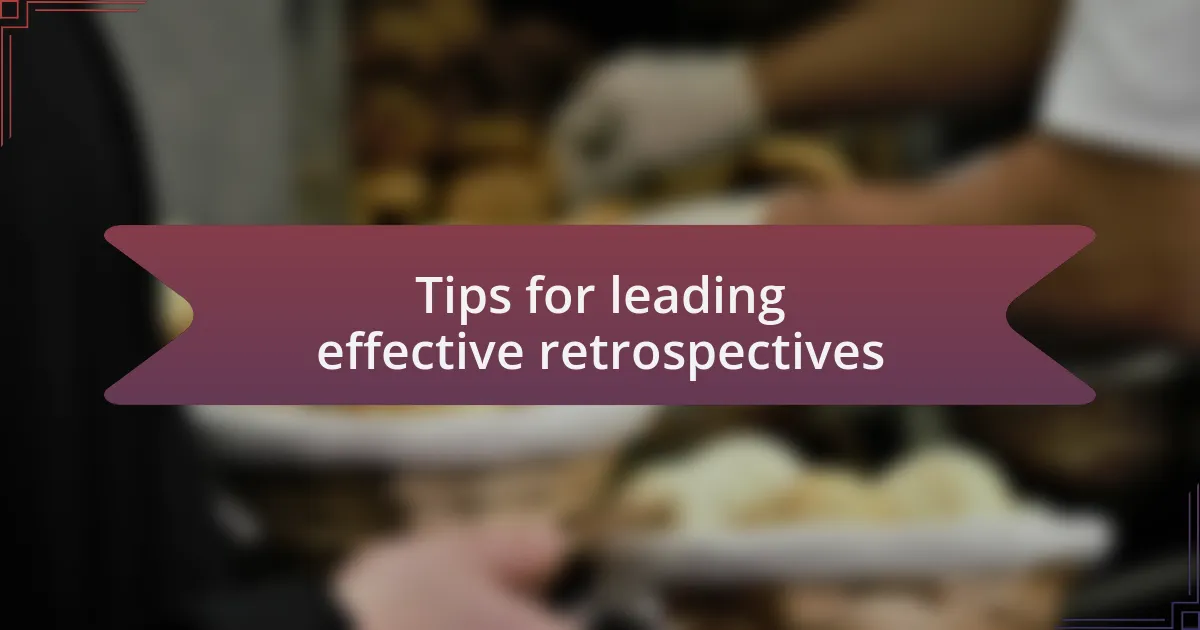
Tips for leading effective retrospectives
When I first started leading retrospectives, I underestimated the power of setting a clear agenda. There was a time when we jumped right in without one, which led to a chaotic discussion and left everyone feeling lost. Once I began outlining key topics in advance, I noticed the team was much more focused and productive. Isn’t it fascinating how a little organization can transform a discussion?
I also learned that it’s crucial to foster a safe environment where everyone feels comfortable sharing their ideas. In one session, I noticed a quieter team member hesitating to contribute. After gently prompting them, they shared a valuable insight that shifted our entire approach. Have you ever witnessed how a single voice can change the trajectory of a team’s strategy? When people feel valued and empowered to speak up, the entire team benefits.
Lastly, utilizing visual aids during retrospectives has proven to be invaluable in my experience. I recall incorporating a timeline to visualize our project’s milestones, which sparked engaging conversations about successes and obstacles. It was remarkable to see how visual elements made abstract discussions concrete and memorable. Why not consider how visuals could enhance not just understanding, but also retention of key points in your meetings?